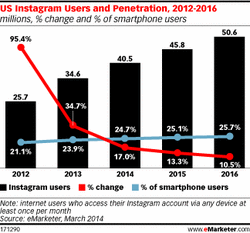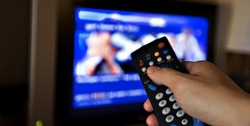
Nearly 35 million people in the US accessed Instagram at least once per month in 2013, according to eMarketer’s latest forecast—representing double-digit but not spectacular growth over 2012. By the end of this year, almost 25% of US smartphone users will snap a photo, slap on a filter and share their creations with friends on Instagram on a monthly basis (or, at least, sign in and check out what their friends are posting).
User counts for Instagram and Twitter are strikingly similar. eMarketer estimates that 43.2 million US consumers used Twitter monthly last year—or 17.6% of the total internet user population. Meanwhile, Instagram users represented 16.1% internet users. Limiting that figure to smartphone Twitter users, Twitter hit just 30.8 million in 2013; this will increase to 37.3 million in 2014, or 22.7% of US smartphone users. Both figures fall slightly below those for total Instagram users, and while Instagram activity all but exclusively takes place on smartphones (meaning Instagram’s smartphone user base could be higher than Twitter’s), it is possible for Instagram users to have an account online without accessing the service through a smartphone. As a point of reference, eMarketer pegs US smartphone Facebook users at 123.7 million this year.
Twitter’s US user base shows signs of maturing in its demographic composition, spreading the user population more evenly across age groups, while Instagram is still largely limited to a pool of millennial and Gen X users. Last year, 69.0% of Instagram’s users were ages 18 to 44. This year, that figure will drop, but only to 67.5%, and over time, Instagram’s user base in these age groups will approach, but not surpass, Twitter’s. eMarketer does not expect significant shifts in usage by age for either site within our forecast period, and Instagram’s user count among 18- to 44-year-olds will remain about 1 million fewer than Twitter’s in each year throughout our forecast.
One demographic shift well under way for Instagram, however, is an evening out in terms of gender. In 2012, about two-thirds of Instagram users were female. While women still make up the majority of users, by 2016 the ratio is expected to reach 55% female vs. 45% male.
eMarketer bases all of our forecasts on a multipronged approach that focuses on both worldwide and local trends in the economy, technology and population, along with company-, product-, country- and demographic-specific trends, and trends in specific consumer behaviors. We analyze quantitative and qualitative data from a variety of research firms, government agencies, media outlets and company reports, weighting each piece of information based on methodology and soundness.







 RSS Feed
RSS Feed